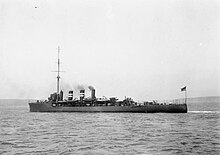Queen Luise (ship, 1913)
|
The Queen Louise as a cruise liner
|
||||||||||||||||||||||
|
||||||||||||||||||||||
|
||||||||||||||||||||||
|
||||||||||||||||||||||
|
||||||||||||||||||||||
The Queen Luise of HAPAG was the most modern German seaside resort ship before the First World War and named after the wife of Friedrich Wilhelm III . At the beginning of the war, the ship was converted into a mine- layer by the Imperial Navy and used against the Thames estuary.
The Queen Louise was lost already in this first use. The British cruiser Amphion was lost on the mines she had laid the following day. It was the first loss of both navies in the world war.
The seaside resort ship Queen Luise
The Queen Luise was the second HAPAG spa ship with a turbine drive after the Kaiser . The first German ship with a hydraulic booster, named after its inventor Föttinger transformer , equipped passenger ship was on May 8, 1913 on the Vulcan shipyard in Szczecin its launch set and was on 29 September 1913 in service. HAPAG used the ship on seaside trips to Heligoland and, from January 27, 1914, also in the Mediterranean in the “Riviera service” between Genoa and Nice , where the Kaiser was first deployed the previous year. On July 31, 1914, Queen Luise made one last trip to Helgoland, in order to be converted in Cuxhaven .
The auxiliary steamer B
On August 1, 1914, the ship was confiscated by the Imperial Navy and, as has already been taken into account in the construction, the auxiliary Trust Mine steamer B remodeled. The exterior was painted black for use as an auxiliary mineship and was initially equipped with two 3.7 cm caliber revolver cannons to enable immediate surprise use. A stronger armament of two 8.8 cm guns was then to be installed in Wilhelmshaven.
With 200 sea mines on board, the ship under Korvettenkapitän Biermann left Emden on August 4, 1914 to lay mines in the Thames estuary. British fishing vessels watched her lay the mines. They informed the British light cruiser Amphion , which was leaving Harwich on August 5 and was accompanied by a squadron of 16 Laforey- class destroyers . The British commander dispatched four destroyers, which Queen Luise stopped when laying a mine barrier . She tried to escape but was taken under heavy fire by the destroyers Lance , Linnet , Landrail and Lark, as well as the Amphion . The German commander then opened the sea valves and ordered the ship to be abandoned, as he could not escape the destroyers and an effective defense was not possible. The scored in fire Queen Luise decreased by 12:22 to 51 ° 52 ' N , 2 ° 30' O as the first German warship the First World War. 46 men were rescued from the British ships, the number of dead varies between 54 and over 100.
The loss of the Amphion
The British ships continue their venture towards the German Bight . On the march back on the following day, the Amphion ran into the mine barrier laid by Queen Luise . The front of the Amphion was damaged by a mine hit ; the ship drifted back into the minefield and was so badly damaged by a second mine hit that it sank about 20 minutes later. About 130 crew members of the Amphion and 18 of Queen Luise who were still on the cruiser perished.
literature
- Carl Herbert: War voyages of German merchant ships . Broschek & Co, Hamburg 1934, DNB 573754594 .
- Hans H. Hildebrand, Albert Röhr, Hans-Otto Steinmetz: The German warships: Biographies - a mirror of naval history from 1815 to the present. Koehlers Verlagsgesellschaft, Herford 1979–1993, DNB 550720391 .
- Arnold Kludas : The History of German Passenger Shipping. Volume III: Rapid growth from 1900 to 1914. (Writings of the German Maritime Museum, Volume 20). Kabel, Hamburg 1988, ISBN 3-8225-0039-9 .
- Herbert Kuke: Helgoland course. Publishing Gerhard Stalling, Oldenburg 1974, ISBN 3-7979-1839-9 .
- Eberhard von Mantey (ed.): At sea undefeated, second volume, JF Lehmanns Verlag, Munich 1922
- Claus Rothe: German seaside ships. 1830 to 1939. In: Library of Ship Types. transpress publishing house for transport, Berlin 1989, ISBN 3-344-00393-3 , pp. 112-113.
Web links
- SMS Queen Luise on deutsche-schutzgebiete.de
- Details on the Königin Luise german-navy.de
Footnotes
- ^ The considerably smaller Adler , bought in 1912 as a turbine ship , received a normal expansion steam engine before it was used as a bath ship, Kuke, p. 84.
- ↑ Kludas, Vol III, p. 112.
- ↑ Hildebrand, Vol. VI, p. 129.
- ↑ Undefeated at sea, p. 10
- ^ Herbert, p. 10.
- ↑ 77 deaths according to Herbert, p. 11 and Hildebrand, Vol. VI, p. 129.

